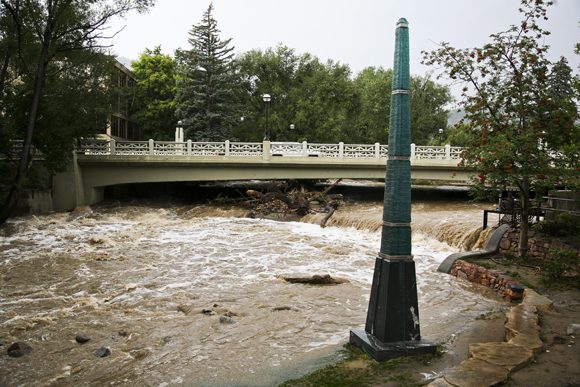
The flooded Boulder Creek is seen behind the Gilbert White flood memorial that shows past flood levels, Saturday, Sept. 14, 2013. (Kai Casey/CU Independent)
Ten years ago, Boulder County experienced one of the biggest natural disasters in its history. Over the course of approximately five days, from Sept. 11 to Sept. 15 in 2013, 17 inches of rain came down, bringing Boulder Creek’s levels to the highest they had been since 1894.
The University of Colorado Boulder’s campus remained relatively safe compared to other areas, due to its elevation. However, campus closed Sep. 12 until Sept. 16, the Sep. 19 football game was postponed and around 120 CU Boulder buildings sustained damage. As students finally returned to classes, the surrounding community had to begin the tough work of rebuilding.
“We are just finally finishing up the full recovery to the flood some ten years later,” said Mike Chard, the director of the Boulder Office of Disaster Management (ODM).
CU Independent photographers captured images of the creek overflow, which destroyed the pedestrian bridge leading from the university’s practice fields, and water rushing past the Boulder Public Library. Residents constructed barriers to protect their homes. Debris gathered in yards and mud covered sidewalks and streets.
Susan Eastman, a longtime Boulder resident who works as a realtor, encountered the damage firsthand as flood water burst through the window wells in her basement and rose to two steps from her main floor.
“I had this huge pile of my life in the backyard,” she said, recalling how she had to gather belongings out of her basement before the water overtook it.
Chard described the intense flooding as a “recipe” of variables including ground saturation from days of rain, a cold front moving in and moisture coming from the Gulf of Mexico. ODM’s response came from lessons learned in previous disasters, such as the 2010 Fourmile Canyon Fire that, at the time, had taken out the most homes of any fire in Colorado history.
ODM set up a call center, coordinated response agencies like police and fire departments and began to track the hundreds of people unaccounted for.
Eastman said she received aid in the immediate aftermath from other community members who responded to her post on social media asking for help.
She said there was a “human chain” of neighbors she had never before met helping her load materials from her flooded basement.
“Financially, we were in difficulty, and then to have this flood take out a third of the house basically, we didn’t have the money to just have it rebuilt,” she said. “And so I learned a lot about asking for help in this situation.”
Chard also said he found community to be important to disaster preparedness and response given the time and effort it takes to distribute resources.
The lessons from each disaster have carried over to the next one, he said, referencing the recent Marshall Fire that burned in Boulder County at the end of 2021.
Back in 2013, CU Boulder created a disaster recovery fund for impacted staff and faculty and, in 2021, following the devastation of the Marshall Fire, recommended affected students and faculty apply for emergency funds through the university.
“That’s how we’ve been able to endure these disasters: is there seems to be a strong sense of [community],” said Chard.
Contact CU Independent Breaking News Editor Ann Marie Vanderveen at ann.vanderveen@colorado.edu.
